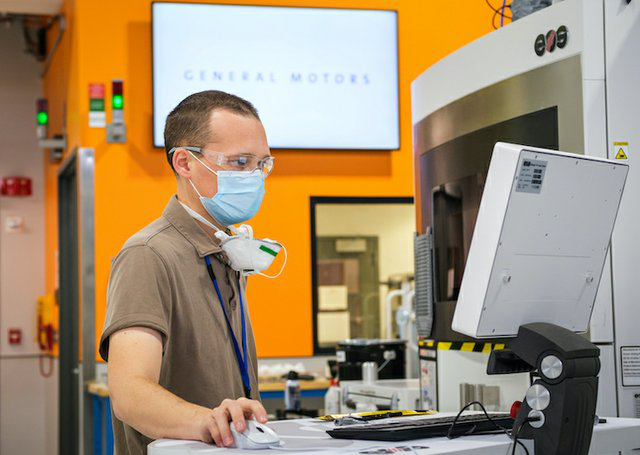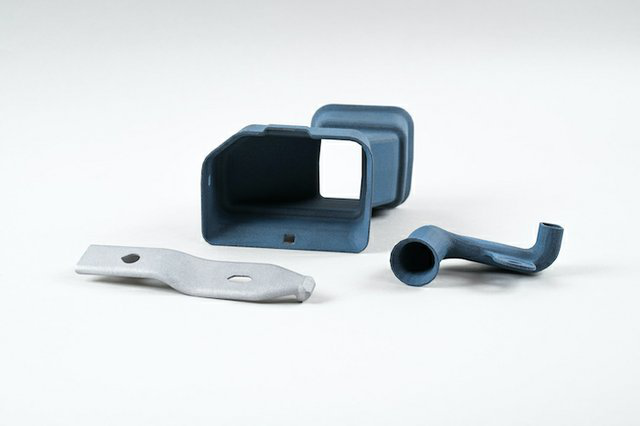
General Motors Manufacturing Engineer Benjamin LeBlanc inspects a 3D printer at the General Motors Additive Industrialization Center at the GM Tech Center in Warren, Michigan. (Photo by Steve Fecht for General Motors)
位于密歇根州沃伦的通用汽车技术中心的增材工业化中心,制造工程师Benjamin LeBlanc正在操作3D打印设备。(图片由Steve Fecht为通用汽车拍摄)
General Motors (GM) has opened a 15,000-square-foot 3D printing facility comprising of a combined 24 metal and polymer platforms.
通用汽车(GM)已经开设了一个15000平方英尺的3D打印设备中心,其中包括24台金属和非金属设备。
The Additive Industrialization Center (AIC) is exclusively dedicated to productionising 3D printing technology within the automotive industry and has been described as the ‘capstone’ of GM’s increased expertise and investment in 3D printing over the last few years.
增材工业化中心(AIC)专门致力于在汽车行业内实现3D打印技术的生产化,该中心被认为是通用汽车过去几年在3D打印领域增加专业知识和投资的 "顶点"。
Within the AIC, GM intends to validate 3D printing technologies and applications, while also ‘pivoting frequently’ to evolve additive machinery and equipment. As is standard in the automotive space, GM already has a good grasp of 3D printing’s capabilities as a prototyping tool, with many of the parts the AIC produces being functional models used within a variety of testing environments for pre-production vehicles. Through this endeavour, GM is said to have enjoyed the elimination of expensive early tooling costs and the ability to iterate quickly across a range of parts, including during the development of the brake cooling ducts on the Chevrolet Corvette where the company reduced time by nine weeks and costs by more than 60%.
在AIC内,通用汽车计划验证3D打印技术和应用,同时发展快速成型机械和设备。作为汽车行业标杆,通用汽车已经很好地掌握了3D打印作为原型设计工具的能力,且许多部件都是在各种测试环境中用于预生产车辆的功能模型。据悉,通过不懈努力,通用汽车已经成功解决了早期工具成本费用昂贵以及一系列零件上快速迭代的问题,包括在雪佛兰科尔维特(Chevrolet Corvette)的制动冷却管道开发过程中,该公司利用增材制造技术将时间缩短了9周,成本降低60%。
“The core component of GM’s transformation is becoming a more agile, innovative company and 3D printing will play a crucial role in that mission,” commented Audley Brown, GM Director of Additive Design and Materials Engineering. “Compared to traditional processes, 3D printing can produce parts in a matter of days versus weeks or months at a significantly lower cost. Many recent product programmes have benefitted from 3D printed prototype parts in one way or another. Not only can these parts save time and money, but the team also uses 3D printed applications during product development to overcome unexpected challenges in real time.”
“通用汽车转型的核心是成为一家敏捷的创新型公司,而3D打印将在这一过程中发挥至关重要的作用。”通用汽车增材设计和材料工程总监Audley Brown说道: “与传统工艺相比,3D打印可以在几天之内以较低的成本生产零件。最近许多产品项目都以某种方式受益于3D打印的原型零件,这些零件不仅可以节省时间和金钱,而且团队还可以在产品开发过程中使用3D打印应用程序来应对一些突发挑战。”

3D printed Cadillac V-Series HVAC ducts and electrical harness bracket made at the GM Additive Industrialization Center at the GM Tech Center in Warren, Michigan. (Photo by Steve Fecht for General Motors)
位于密歇根州沃伦通用汽车技术中心的增材制造工业化中心制作的3D打印凯迪拉克V系列暖通空调管道和线束支架。(图片由Steve Fecht为通用汽车拍摄)
GM is aiming to now push ahead and expand the application envelope of its 3D printing capacity. It is also additively manufacturing hand-apply tools, automation components and rapid-response solutions for production site launches, with 3D printing allowing the company to consolidate designs, reduce components and generate lighter tools. The company 3D printed almost 100 hand-apply tools for the launch of its new full-size SUVs, for example, in a nylon carbon fibre composite instead of aluminium, bringing the weight down from between 10 and 40 pounds to just 3.
通用汽车目前正致力于推进和扩大3D打印的应用范围,他们还通过增材制造生产手动工具、自动化组件和快速响应解决方案,能够合并设计,减少零件数量并减轻重量。例如,他们使用设备3D打印了近100个手工应用工具,用于新款全尺寸的SUV,他们使用了尼龙碳纤维复合材料代替铝材,重量从30磅降至仅3磅。
“GM is increasingly applying the benefits of 3D printing, from prototype development to manufacturing tooling and production vehicles,” said Ron Daul, GM Director of Additive Manufacturing and Polymer Centres. “With the opening of the AIC, we’ll continue to accelerate adoption of this technology across the organisation.”
“从原型开发到制造工具和生产车辆,通用汽车正在越来越多地应用3D打印的优势。”通用汽车增材制造和聚合物中心总监Ron Daul表示:“随着AIC的启用,我们将继续加快增材制造应用。”
With the opening of the AIC, however, the company wants to go further than this and begin producing end-use parts that go on the final vehicle. Recently, Cadilllac announced its CT4-V Blackwing and CT5-V Blackwing will be the first GM production vehicles to have 3D printed parts. These components include an emblem on the manual shifter knob, an electrical harness bracket and two HVAC ducts, all manufactured at reduced costs and increases efficiencies, per GM. It represents a significant milestone for GM, who now hope to accelerate the production of 3D printed end-use components.
随着AIC投入使用,公司希望更进一步生产车辆上的终端部件。近日,凯迪拉克宣布CT4-V Blackwing和CT5-V Blackwing将成为通用汽车首批采用3D打印部件的量产车。这些部件包括手动换挡旋钮上的一个徽章、一个电线束支架和两个HVAC管道,均以降低成本和提高效率的方式生产。这对通用汽车来说是一个重要的里程碑,他们希望加快3D打印终端部件的量产。
“The parts printed for the Cadillac V-Series models exemplify how we can use additive applications in the right place on the right programme,” offered Brown. “And this is just the beginning. Ultimately, we see the potential for 3D printed parts to be used in a wide variety of production applications – from greater personalisation options for new vehicle buyers to unique accessories and reproductions of classic car parts.”
Brown指出:“为凯迪拉克V系列车型打印的零件体现了我们选择增材制造的正确性,,未来,我们认为3D打印零部件有可能被广泛应用于各种生产应用——从为新车购买者提供更个性化的选择,到独特的配件,甚至是经典款汽车零部件的复制品。”